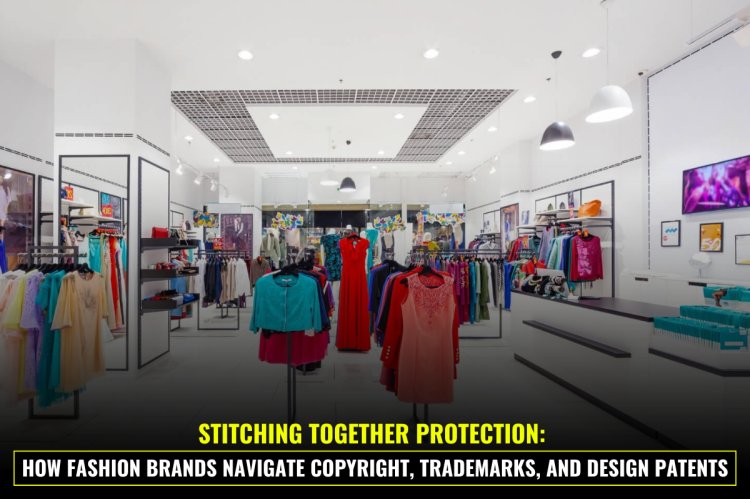Stitching Together Protection: How Fashion Brands Navigate Copyright, Trademarks, and Design Patents
The global fashion industry thrives on creativity and innovation, but protecting original designs remains a challenge due to varying intellectual property (IP) laws. Fashion brands rely on a mix of copyright, trademarks, and design patents to safeguard their work. This blog explores key legal frameworks, landmark cases, and emerging trends in fashion IP protection, particularly in the digital era where counterfeiting and virtual fashion are on the rise. It delves into copyright protection for artistic elements, trademark enforcement against counterfeit goods, and the role of design patents in preserving unique fashion aesthetics. Additionally, it examines the impact of digital fashion, NFTs, AI-generated designs, and legislative reforms shaping the future of fashion IP protection.

Introduction
Fashion is a fast-evolving industry where originality is constantly at risk of imitation. Unlike industries such as music and film, where copyright protection is straightforward, fashion designs often fall into legal gray areas. To combat imitation and counterfeiting, brands employ a combination of copyright, trademarks, and design patents. This article delves into the complexities of fashion IP protection and the evolving strategies brands use to enforce their rights.
Copyright in Fashion
Understanding Copyright Law in Fashion
Copyright law protects creative works but generally does not cover functional objects, including clothing. However, certain artistic elements within fashion—such as fabric patterns, embroidery, and sculptural designs—may qualify for copyright protection.
Landmark Case: Star Athletica, LLC v. Varsity Brands, Inc. (2017)
In this case, the U.S. Supreme Court ruled that the decorative elements of cheerleading uniforms could be copyrighted if they were separable from the functional aspects of the garment. This ruling set a precedent for fashion copyright claims, reinforcing the importance of distinct artistic elements in obtaining protection.
Regional Differences in Copyright Protection
- United States: Limited protection for fashion, requiring distinct artistic elements.
- European Union: The Unregistered Community Design Right (UCDR) offers automatic three-year protection for original designs, providing broader coverage than U.S. law.
Trademarks in Fashion
What Are Trademarks and Why Do They Matter?
Trademarks protect brand identity, covering names, logos, slogans, and even distinctive product designs (trade dress). Luxury brands heavily rely on trademarks to safeguard their brand equity.
Notable Case: Christian Louboutin S.A. v. Yves Saint Laurent America Inc. (2012)
This case upheld Louboutin’s trademark protection for its iconic red sole, establishing that distinctive product features can be legally protected if they acquire secondary meaning associated with a brand.
Challenges in Trademark Enforcement
- Counterfeit goods flooding online marketplaces like Amazon and Alibaba.
- Fast fashion brands mimicking luxury designs with minor alterations to avoid infringement claims.
- Innovative anti-counterfeiting measures, such as blockchain-based authentication and QR-coded product tags.
To know more about this you can follow the li nk below:
<iframe width="560" height="315" src="https://www.youtube.com/embed/_c5KBf9WAfw?si=EsIJiIqqA5GDpaFI" title="YouTube video player" frameborder="0" allow="accelerometer; autoplay; clipboard-write; encrypted-media; gyroscope; picture-in-picture; web-share" referrerpolicy="strict-origin-when-cross-origin" allowfullscreen></iframe>
Design Patents in Fashion
How Design Patents Work
Design patents protect the ornamental design of an article of manufacture for 15 years in the U.S. They are particularly useful for footwear, accessories, and distinctive fashion silhouettes.
Examples of Design Patent Protection
- Nike’s sneaker designs, including the Air Force 1, have been patented to prevent knockoffs.
- Apple’s legal battles with Samsung have influenced how fashion brands approach design patent enforcement.
Limitations of Design Patents
- The application process is time-consuming and costly.
- Fast-changing trends in fashion make design patents less practical.
- 3D printing has made it easier for counterfeiters to replicate patented designs.
Trade Dress and Unfair Competition Laws in Fashion
What is Trade Dress?
Trade dress protects the overall visual appearance of a product, including shape, packaging, and color schemes. It serves as an extension of trademark law.
Key Cases in Trade Dress Protection
- Two Pesos, Inc. v. Taco Cabana, Inc. (1992): Established that trade dress can be inherently distinctive and legally protected.
- Christian Louboutin SAS v. Pawan Kumar (2018): The Delhi High Court recognized Louboutin’s red sole as a distinctive trade dress.
Role of Unfair Competition Laws
Unfair competition laws help brands combat deceptive practices like passing off and false advertising. However, enforcement remains challenging across different jurisdictions.
Emerging Trends in Fashion IP Protection
The Rise of Digital Fashion and NFTs
- Brands like Gucci and Balenciaga are entering the digital fashion space.
- Legal uncertainties surrounding ownership and infringement of virtual fashion assets.
- The need for updated IP frameworks to address digital piracy.
AI-Generated Fashion Designs
- Growing use of AI in design raises questions about authorship and ownership rights.
- Can an algorithm own a design? Legal scholars continue to debate this issue.
Legislative Reforms in Fashion IP
- The U.S. Design Piracy Prohibition Act proposes expanded copyright protection for fashion designs.
- If passed, this could significantly change how designers protect their work.
Challenges in Enforcement and Future Considerations
Difficulties in IP Enforcement
- Counterfeit production thrives in regions with weak IP laws.
- Legal battles are costly and time-consuming for fashion brands.
- Global inconsistency in IP laws complicates protection efforts.
Potential Solutions for Stronger IP Protection
- Harmonization of International IP Laws: More uniform global protection standards.
- Technological Innovations: AI-driven anti-counterfeiting tools, blockchain authentication, and smart tags.
- Consumer Awareness Campaigns: Educating consumers about counterfeit risks and ethical fashion choices.
Conclusion
Fashion brands must take a multifaceted approach to IP protection. While copyright has limitations, trademarks and design patents play a critical role in safeguarding brand identity and innovation. As fashion evolves in both physical and digital spaces, legal strategies must adapt to emerging challenges. Strengthening global IP laws, leveraging technology, and updating legal frameworks will be crucial in ensuring continued protection for the fashion industry’s creative output.












